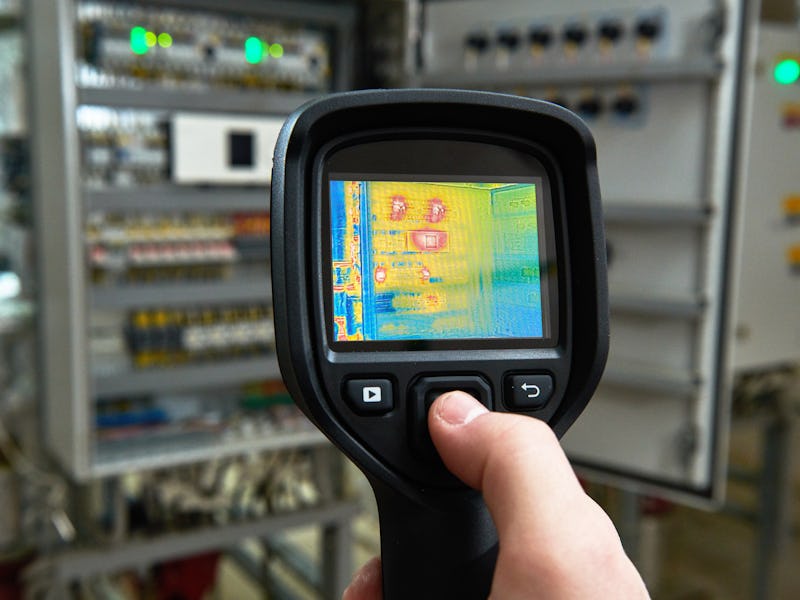Thermal imaging might have met its match in this new coating.
Scientists say new infrared resistant materials could be crucial to individual privacy.

It’s common knowledge that objects glow more brightly as they get hotter, but scientists in a new study say it doesn’t have to be this way. They’ve designed a chemical coating that not only “breaks” this physical law but could help protect our privacy as well.
We’re used to worrying about protecting our digital data privacy, but we’re helpless against another constant data leak: our own body heat. The soft orange glow you and your phone emit while lounging in bed might seem innocuous, but thermal imaging and infrared cameras can transform this information into targeted tracking data.
While such a scenario may seem more like science-fiction than reality, such a case was brought to the United States Supreme Court almost twenty-years ago in 2001. In the case, Kyllo v. United States, the United States Department of the Interior used an infrared camera to determine whether or not Danny Lee Kyllo was growing marijuana illegally at his home in Oregon. After observing higher heat levels in Kyllo’s garage (assumedly from heat lamps used to grow the plants) the Department of the Interior then obtained a search warrant and discovered the plants.
While Kyllo did ultimately plead guilty to growing the plants, he claimed that the use of an infrared camera to secretly observe heat signatures from his house without a warrant was unconstitutional. And the Supreme Court agreed.
Now, nearly thirty-years after Kyllo’s initial run-in with the law, thermal imaging has become commonplace. Coast to coast, from Walla Walla, Washington to rural Kansas to Manchester, New Hampshire, thermal imagining has become a routine tool for police. But now, scientists have discovered a way to camouflage objects and even clothing from prying infrared cameras.
The approach, which was described in a study published this December in the journal Proceedings of the National Academy of Sciences, uses a thin coating of a unique material called samarium nickel oxide to control what heat signature an object emits at different temperatures.
Mikhail Kats, a co-author of the study and UW-Madison professor of electrical and computer engineering, said in a statement that this represents the first time thermal properties have been decoupled from an object.
“This is the first time temperature and thermal light emission have been decoupled in a solid object,” says Kats. “We built a coating that ‘breaks’ the relationship between temperature and thermal radiation in a very particular way. Essentially, there is a temperature range within which the power of the thermal radiation emitted by our coating stays the same.”
In the study, the authors write that their coating material is able to exhibit these characteristics thanks to its unique, and fully-reversible, phase transitions between insulator and metal. These “strong but gradual” phase transitions allowed the researchers to control the emissivity (e.g. how much light an object emits in relation to its temperature) within certain temperature ranges. In this case, between approximately 105 and 135 degrees Celsius.
Heat emissivity of untreated sapphire (second from top) compared to emissivity of treated sapphire (bottom two rows).
To demonstrate the efficacy of their coating versus a standard heat-emitting object, the team conducted an experiment that compared a coated piece of sapphire with a “normal” piece of sapphire. For each sample, part was placed near a heater and part was extended into the cooler, open air. When both pieces of sapphire were examined using an infrared camera the team saw a stereotypical change in light emission from the hotter to the cooler region of the non-coated sapphire while the coated sapphire maintained much more uniformity in its heat emission.
While restricted to a narrow window of temperatures now, Alireza Shahsafi, one of the study’s lead authors, said in a statement that he believes this approach could have a big impact on how we view thermal privacy in years to come.
“We can imagine a future where infrared imaging is much more common, negatively impacting personal privacy,” Shahsafi said. “If we could cover the outside of clothing or even a vehicle with a coating of this type, an infrared camera would have a harder time distinguishing what is underneath. View it as an infrared privacy shield. The effect relies on changes in the optical properties of our coating due to a change in temperature. Thus, the thermal radiation of the surface is dramatically changed and can confuse an infrared camera.”
In addition to privacy concerns, the authors write that such a coating could also be used to build quantum materials that will require carefully controlled heat transfer.
Read the abstract here:
Thermal emission is the process by which all objects at nonzero temperatures emit light and is well described by the Planck, Kirchhoff, and Stefan–Boltzmann laws. For most solids, the thermally emitted power increases monotonically with temperature in a one-to-one relationship that enables applications such as infrared imaging and noncontact thermometry. Here, we demonstrated ultrathin thermal emitters that violate this one-to-one relationship via the use of samarium nickel oxide (SmNiO3), a strongly correlated quantum material that undergoes a fully reversible, temperature driven solid-state phase transition. The smooth and hysteresis-free nature of this unique insulator-to-metal phase transition enabled us to engineer the temperature dependence of emissivity to precisely cancel out the intrinsic blackbody profile described by the Stefan–Boltzmann law, for both heating and cooling. Our design results in temperature-independent thermally emitted power within the long-wave atmospheric transparency window (wavelengths of 8 to 14 μm), across a broad temperature range of ∼30 °C, centered around ∼120 °C. The ability to decouple temperature and thermal emission opens a gateway for controlling the visibility of objects to infrared cameras and, more broadly, opportunities for quantum materials in controlling heat transfer.